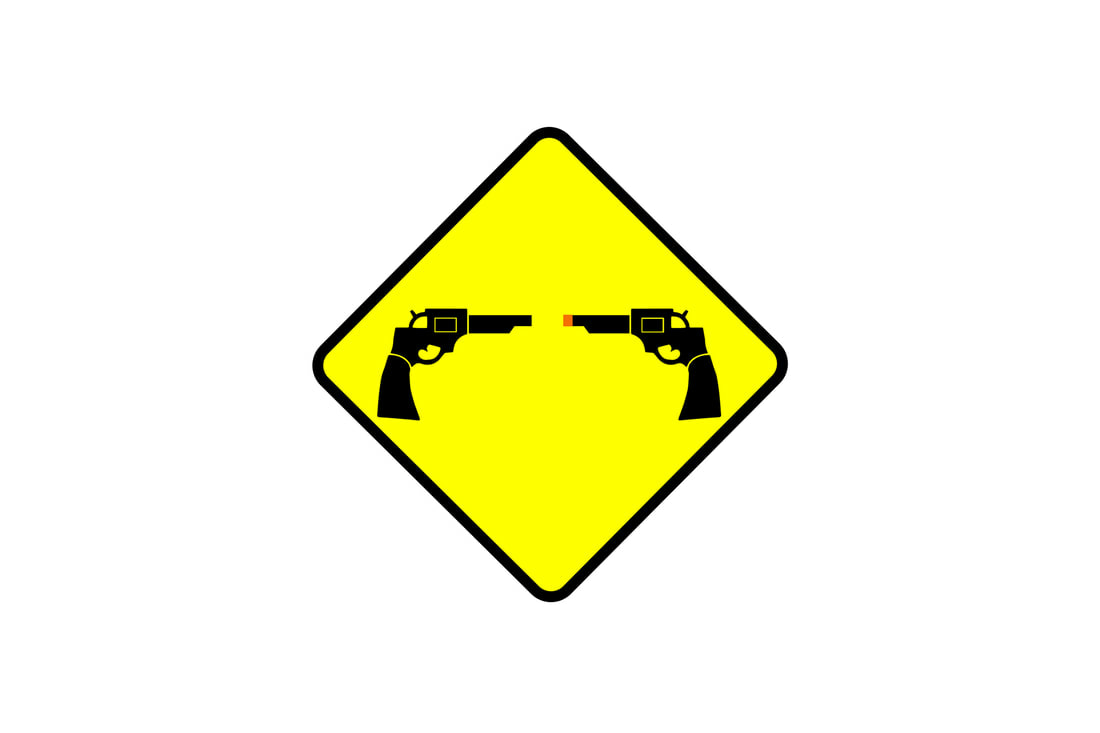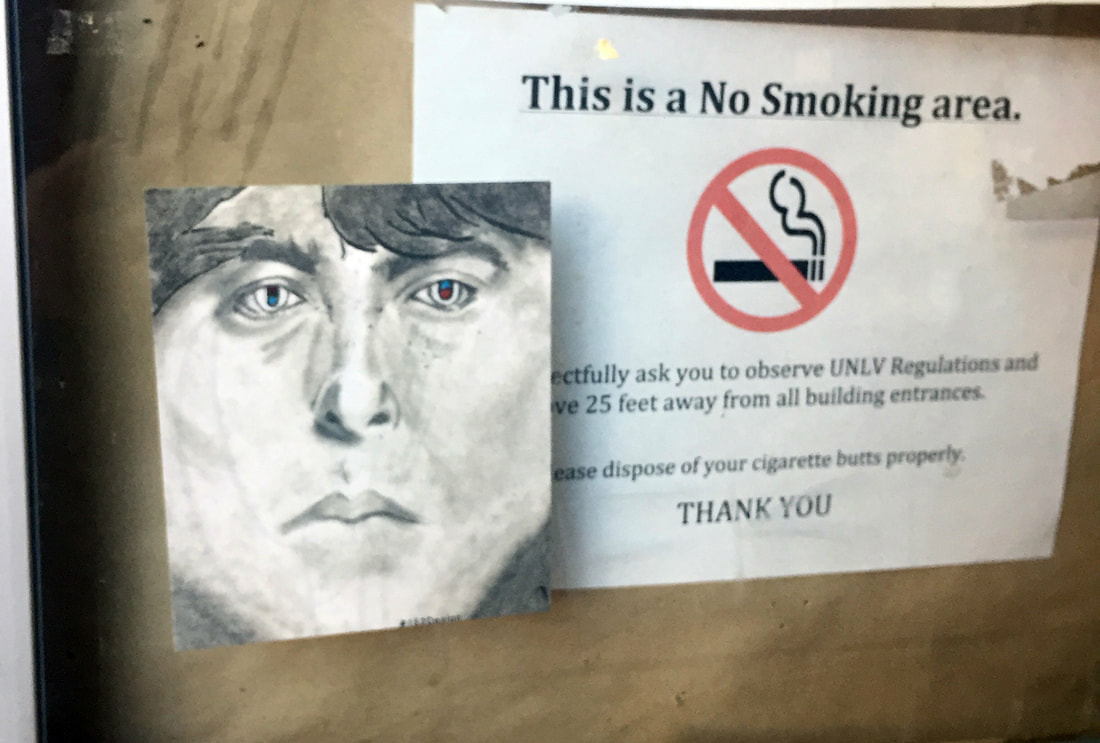|
"(Left) Hear Us" Installation 2018 (Right) Poster by Christina Uran. Graphic Design is no longer be a vestige discipline at the University of Nevada, Las Vegas. The College of Fine Arts has added design faculty and resources, and now it can keep up with a grounded photography program. Both design and photography can aim to match the gravitas of the painters and sculptors who graduated from the BFA and MFA programs. It also opens the door for 2D Design Fundamentals, a core class in any art program, to show how basics can be adjusted to an incoming wave of design students, and not just be a gateway to painting, drawing, and sculpture. And yea, I used the method of street art When I polled my 2D basic students on the first night of the fall semester, hands showed more than half were graphic design majors. That had me adjust the entry point in understanding the basics and consider the opening project use street art as the end execution. That aesthetic gives experienced and novice art students a shared starting point (other than comics and gaming). During the second class in the first week of the semester, ideas came out of a discussion on campus safety. In anticipation of events marking the first anniversary of October 1, students were asked if events from a year ago was still on their mind, and what was their point of view? The conversation was revealing. Because of that talk that became about campus safety, that provided content. An early assignment called “Visual Statement” was modified to respond to some of the topics brought up that night. The work made a debut, rather an infiltration, at the 2nd Annual Art Walk on October 12, days after a flurry of memorials were held. (UNLV is ten minutes away from the grounds where a gunman fired into the concert grounds). It also gave students the chance to create unsanctioned artwork executed outside of the context of traditional art venues. Though not in the street, the installation had foot traffic when people attending the art walk entered the courtyard. They were temporary works that can be pulled down easily, still a subsequent incarnation of stencil work, wheat-pastes and sticker art, the common forms of modern street art. They were installed on a door of the classroom numbered 152. Each piece uses the hashtag of #152Design. The classroom is across the way from an older guerrilla project; a large paper-mache ear, presumably representing Van Gogh’s lost appendage. The ear has been adopted by the art department and now a landmark piece. Building services even paints it the same color as Grant Hall when they spiffy up the building. It is also a mascot. Now the ear speaks. With the arrival of new chair Marcus Civin, it has been given its own Instagram account. While some of the names of the individual pieces were still waiting to be set by the artists, as a collective, near the ear, it became an installation titled “Hear Us.” The first directive was to make a statement on a caution sign. It strayed as artists played with the ideas of how design basics solve the problem of saying something with clarity to communicate a message. The usual practice of shading and perspective was traded out for coming up with an idea, play with balance, thinking of positive and negative space, forming a stronger sense of line and form to make it work; all to make an abstract idea clear. It also became a way to introduce students how to explain the work without the jumble of academia prose. When they pitched their ideas, they were instructed that was the beginning of an artist’s statement. They were to expand the pitch into a written assignment. Courtesy Megan Lufcy A few stayed with the original prompt of the image on a traffic warning sign; black graphic on a yellow background. “Two guns are pointed at each other, and one is a toy gun with an orange tip. Other than that, they look exactly the same,” wrote Megan Lufcy. “It's meant to get the viewer to think about the gun obsession in our country. We even give toy guns to children, and then wonder why they can't tell the difference when there's an accident with a real gun. I wasn't allowed to play with toy guns as a child, so that issue has always confused me.” Courtesy Patrick Manabat Some stayed with gun safety, but Patrick Manabat did not use the idea of a sign. “I originally wanted to emphasize the menacing look of the gun in contrast to the confetti which represents something more flamboyant; however, I felt that it could be interpreted in many different ways,” said Manabat. “I decided to leave that aspect as a part of the piece. This was just to get people thinking about the idea of gun safety, and to spark insight on the topic itself.” Others expanded beyond guns, but still stayed within the framework of “Visual Statement” as a personal comment. If there was another subject of safety they preferred to speak to, and their pitch was well thought out, it was accepted. Often the image became more personal. Daniel Darden had thoughts on prescription drugs. Courtesy Daniel Darden “Many people see prescription drugs as trustworthy since they are legal and come from a doctor, but there is a dark face behind what long term use and abuse of these drugs can do,” wrote Darden. “College students are always warned about drug use, but it seems that the message is off track and doesn’t stick a lot of the time. I believe this is because students are pushed to make their grades a priority over their mental health.” Courtesy Michelle Harper Michelle Harper used the assignment as the chance to question the school mascot, and deconstructed the meaning of Rebel. “With UNLV being an extremely diverse school, I thought the mascot should be as well. I reimagined the mascot as an indigenous man wearing a mask. I figured that with no specific race, many students could relate and identify with him more,” said Harper, whose hip vigilante “embraces the rebel culture we have at our school.” During the critique stage, the class was visited by Las Vegas-based street artists Sage Sage (There She Is Art) and Shawn Gatlin (You Killed Me First), whose wheat-pastes are seen primarily in the Las Vegas arts district and Melrose Avenue in Los Angeles. The work from the class in room 152, thus the hashtag 152 design, follows cues from guerilla artists who create community relevant content that brings ephemeral attention to social causes through "art provocation." Courtesy Marlyne Lopez
There were also opposing ideas. Marlyne Lopez preferred to be hopeful in a time of difficult questions. Her reasoning on the discussion was valid, and she was encouraged to approach the direction that was forming in her mind. In her statement she later wrote: It seems that people want to have strong, unrelenting opinions. Terrible things happen, and that causes less conversation and more confrontation. Many people have wrestled with this aspect of society, trying to find solutions to it. Flower Essence Repertory by Patricia Kaminski has a unique take on the Baby Blue Eye Flower. Kaminski uses the flower to treat what feels uncompassionate, the loss of trusting others, a loss of innocence. I am not proposing that everyone should use flower oil. I am stating that everyone, to some degree, understands loss. This art is reminder to find a way to be less cynical and to be honest. It doesn't have to be drastic, just being able to have honest discussion with others. This isn’t to say that opposing thoughts are invalid, or we should ignore issues. When negative things are overwhelming, we should also look around at the big world, and realize that bad things don’t define how we are, how we see the world, and how we see one another. Good can be found where we wouldn't have thought to look. After a storm, the sky is still there, and a flower will bloom. Lopez's art and statement was a gentle counterpoint to cautionary messages. These undergrads not exhibited in galleries during art walk have them be like street artists isolated from the formal art world. By coming up with a concept, solution, then the application of basics to make an abstract idea clearer, they voiced ideas in public space, near the site of the October 1 shooting. That added meaning to the vulnerability and voice of students on an open campus.
0 Comments
Leave a Reply. |
An Online Arts JournalExhibition:
February 2 – March 31, 2019 Artist Reception and Gallery Talk: Sunday, February 10, 2019, 4 p.m.–7 p.m. SPONSOR
Archives
February 2019
Categories |










 RSS Feed
RSS Feed